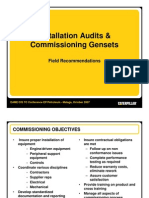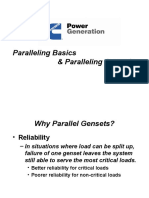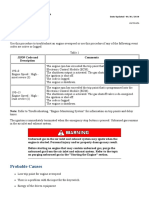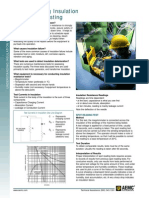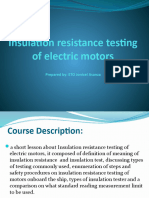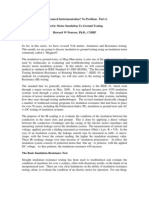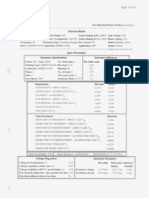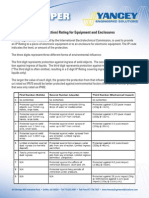Generator Insulation Testing
TC Conference Malaga October 2007
EAME/CIS TC Conference EP/Petroleum - Malaga, October 2007
�Agenda
Purpose When to Test Safety Prepare for the Test The Tests Post Test References Other Tests
EAME/CIS TC Conference EP/Petroleum - Malaga, October 2007
�Insulation Quality
Insulation Degrades Due To: Electrical Stress Mechanical Stress Chemical Attack Thermal Stress Environmental Contamination Time Can be Measured >> Maintenance Tool Insulation resistance as high as 55 GOhm
EAME/CIS TC Conference EP/Petroleum - Malaga, October 2007
�Generator Insulation Testing purpose
Manage the generator maintenance Determine the condition of the insulation Identify insulation systems in need of drying Identify potential future or immediate repair need
EAME/CIS TC Conference EP/Petroleum - Malaga, October 2007
�When is it Necessary to Test the Generator Insulation?
After receipt of generator Before storing Before initial startup This Is The Base-Line Prior to commissioning Dont commission if results are questionable! Prior to running after long period of no use After routine maintenance Periodically KEEP RECORDS of all test results
EAME/CIS TC Conference EP/Petroleum - Malaga, October 2007
�Periodic Testing
Annually in clean, controlled environment Quarterly in severe environments High humidity Water or snow ingestion Smoke Chemicals in air Salty air (such as near the ocean) Dusty environments (sand) Construction debris
EAME/CIS TC Conference EP/Petroleum - Malaga, October 2007
�Monitoring Operations
Trending Understand the Monitored Process Normalized Readings Record on Chart Focus on Changes Occurring Over Time A plot of results over time Deterioration over time Abrupt changes from normal For example when moisture makes its way into the windings Scheduled Repairs Instead of Unplanned Downtime Requires normalized test results
EAME/CIS TC Conference EP/Petroleum - Malaga, October 2007
�Safety
EAME/CIS TC Conference EP/Petroleum - Malaga, October 2007
�Insulation Testing Safety Preparations
People Have multiple people present for testing Electrical safety training ! Comply with all applicable safety standards For example IEEE510 First aid training ! Before testing Isolate the system to be tested Lock it out Barricade around the generator to keep people away Use personal protection devices Dissipate stored energy before the test Short circuit the windings Use a grounding stick for high voltages
EAME/CIS TC Conference EP/Petroleum - Malaga, October 2007
�Insulation Testing Safety
During testing External arcing can occur For example if bare conductor is too close to ground Stay clear of the test equipment, conductors, and item being tested After testing Dissipate the energy after the test Short circuit the windings Use a grounding stick for high voltages Leave short circuited for 5x to 10x test duration
EAME/CIS TC Conference EP/Petroleum - Malaga, October 2007
�Pre-Test
Understanding the test process Tester selection Testing voltage Temperature compensation Guard terminal
EAME/CIS TC Conference EP/Petroleum - Malaga, October 2007
�Test Process
READ instruction manual of your instrument for detailed instructions Test safety is paramount Test Process Apply a Test Voltage Less Than or Equal to Generator Operating Voltage Test Current Will Flow Measure response
EAME/CIS TC Conference EP/Petroleum - Malaga, October 2007
�Test Current Components
Different processes cause insulation current to flow Leakage Current High resistance in parallel with insulation capacitance Reaches constant value quickly Polarization (absorption) Current Electric field causes charges to align themselves to the field Moisture & contamination has large impact Duration in generators is usually minutes or more Capacitive Charging Current Initially large, goes to zero Duration relatively short but not insignificant
EAME/CIS TC Conference EP/Petroleum - Malaga, October 2007
�Insulation Tester Selection
Tester models available from multiple vendors EAMC (Chauvin Arnoux) Megger Numerous others Newer models are very portable Key things to look for Adequate range At least to 100 GigaOhm (100,000 MegaOhm) Preprogrammed, automatic tests Test voltages 500 Vdc, 1,000 Vdc, 5,000 Vdc Calibration program Scheduled maintenance options
EAME/CIS TC Conference EP/Petroleum - Malaga, October 2007
�Testing Voltage
Test at a voltage near the rated voltage Higher voltage Increases stress More likely to find weakness More expensive test as voltage goes up GM EMD study on their locomotive generators 5k Vdc is sufficient
EAME/CIS TC Conference EP/Petroleum - Malaga, October 2007
�Test Voltage Recommendations
Main Stators Low voltage generators (100 v 500 v) Test at 500 Vdc Low voltage generators (500 v 1000 v) Test at 1,000 Vdc Medium voltage generators (2,400 v 7,200 v) Test at 5,000 Vdc High voltage generators (10,000 v 15,000 v) Test at 5,000 Vdc Can be tested at 10,000 Vdc Main rotors Test at 500 Vdc Exciters (stator and rotor) Test at 500 Vdc
EAME/CIS TC Conference EP/Petroleum - Malaga, October 2007
�Three phase machine testing
Preferred to test each phase separately Significantly different results for each phase are a concern Can test three phases at once
EAME/CIS TC Conference EP/Petroleum - Malaga, October 2007
�Interpreting the Results
General result interpretation rules are included Result interpretations are device dependent Test history Other vital information Previous history of the machine Careful visual inspection Comparison with like devices in like circumstances Log of previous testing Possible outcomes Machine is returned to service Schedule repairs Clean, dry, retest Repair immediately, retest Replace machine
EAME/CIS TC Conference EP/Petroleum - Malaga, October 2007
�Temperature Compensation
Insulation resistance measurements are temperature dependent Normalize to a standard temperature Typically either 25 C or 40 C Get exact temperature coefficient from manufacturer Rough estimate Resistance is cut by 50% for 10 C increase in temperature
EAME/CIS TC Conference EP/Petroleum - Malaga, October 2007
�Guard Terminal - Leakage Current
Leakage currents in parallel with the insulation Voltage tracking Surface currents on exposed insulation Can give false low resistance readings Guard terminal connection Part of instrument Eliminates undesired currents Must be isolated from other connections Guard against flashover Usually connected to ground through a low impedance connection Older instruments may connect guard to high potential through a low impedance!
EAME/CIS TC Conference EP/Petroleum - Malaga, October 2007
�Flashover
Be prepared for arcing Not common but does happen Will distort results if not prevented Careful Internal arcing Test failure External arcing Bare conductors too close together or too close to ground Voltage tracking on insulation?
EAME/CIS TC Conference EP/Petroleum - Malaga, October 2007
�Insulation Quality Tests
Visual Inspection Insulation resistance Polarization Index Dielectric Absorption Ratio Dielectric Discharge Step Voltage Hi-pot Other tests (appendix) Isothermal Relaxation Current (KDA test) EDA Test Power Factor Test
EAME/CIS TC Conference EP/Petroleum - Malaga, October 2007
�Visual Inspection
Quick Look at Appearance Remove Terminal Box Panel Look at Winding End Turns Using Flashlight Can look at internals with boroscope Indications Cleanliness Voltage Tracking Visual Damage Black from arcing Discolored steel from overheating Cracking from multiple causes
EAME/CIS TC Conference EP/Petroleum - Malaga, October 2007
�Basic insulation resistance
Insulation resistance reading Resistance Temperature of insulation (windings) Or reference temperature if normalized Length of time voltage applied before reading Document instrument used Calibration This basic test should be done regularly Use trend charts
EAME/CIS TC Conference EP/Petroleum - Malaga, October 2007
�Insulation resistance Test Considerations
Insulation resistance measurements are temperature sensitive Resistance measurements without the winding temperature are meaningless! Use the resistance reading at same point in time Suggest at 60 sec Allows for dissipation of short time constant currents
EAME/CIS TC Conference EP/Petroleum - Malaga, October 2007
�Insulation resistance 3-Phase Test Process
3-Phase testing Lock out device under test Discharge leads Measure winding temperature Disconnect the 3 phases from the load, PTs, ground (neutral side) Connect the 3 phases together Hook up tester See tester instruction manual High side to the phase leads Low side to the core (laminations), steel frame, or rotor shaft Ground the frame Apply voltage Take reading - Typically after 60 sec Discharge windings Tester may have provision for discharging Disconnect
EAME/CIS TC Conference EP/Petroleum - Malaga, October 2007
�Insulation resistance 1-Phase Test Process
1-Phase testing Lock out device under test Discharge leads Measure winding temperature Disconnect the 3 phases from the load, PTs, ground (neutral side) Connect the 2 phases not tested to the core, frame, or shaft Hook up tester See tester instruction manual High side to the phase lead Low side to the core (laminations), steel frame, or rotor shaft Ground the frame Apply voltage Take reading - Typically after 60 sec Discharge windings Tester may have provision for discharging Disconnect
EAME/CIS TC Conference EP/Petroleum - Malaga, October 2007
�Insulation Resistance - Results Interpretation
Interpretation of resistances corrected to 25 C (or 40 C) Dry, new generator Very high resistance Typically higher than 1,000 MOhm (1 GOhm) Can be as high as 50,000 MOhm (50 GOhm) Used generator Anywhere from a few MOhm to many GOhm Generator in questionable condition Significant decrease from readings when new Low MOhm readings Significant difference between phase readings Significant difference between component readings Main stator, main rotor, exciter stator, exciter rotor, PMG stator
EAME/CIS TC Conference EP/Petroleum - Malaga, October 2007
�Polarization Index (PI)
Measurement The ratio of 10 min. reading to 1 min. reading Valuable test if no historical readings are available Sensitive to moisture in or contamination of Insulation Indicates Moisture Content of the Insulation Good Indicator of the Drying Process Will not indicate the failure of an insulation layer in a multi-layer insulation Does not work if there is no absorption current
EAME/CIS TC Conference EP/Petroleum - Malaga, October 2007
�PI Results Interpretation
PI > 6 Very good Usually only seen when winding system is new Newer designs 1.5 < PI < 6 Normal range PI < 1.5 Significant moisture in the windings Failure may occur at any time Recommend to clean and dry immediately Older designs 2 < PI < 6 Normal range PI < 2 Significant moisture in the windings Failure may occur at any time Recommend to clean and dry immediately
EAME/CIS TC Conference EP/Petroleum - Malaga, October 2007
�Dielectric Absorption Ratio (DAR)
Similar to Polarization Index Time at measurements different One typical combination is 60 sec divide by 30 sec reading > 1.4 is good Interpretation more difficult because currents may not have stabilized Far less common than Polarization Index
EAME/CIS TC Conference EP/Petroleum - Malaga, October 2007
�Dielectric Discharge (DD)
Measurement Insulation is Charged to Stable Condition Insulation Discharge Current is Measured Voltage & Capacitance also measured Dielectric Discharge = I1 min / (V * C) Indicates Moisture Content Internal Damage to a Single Insulation Layer
EAME/CIS TC Conference EP/Petroleum - Malaga, October 2007
�DD Results Interpretation
DD > 7 Layer of multilayer insulation is damaged 4 < DD < 7 Questionable, damage may be possible 2 < DD < 4 Poor DD < 2 Good
EAME/CIS TC Conference EP/Petroleum - Malaga, October 2007
�Step Voltage
Measurement Response to Increasing Voltage Steps Differences in Response Between Increasing Voltage Steps Indicates Local Weak Spots Response Changes as Electrical Stress is Increased Comments Use trend analysis. Used for medium or high voltage windings
EAME/CIS TC Conference EP/Petroleum - Malaga, October 2007
�Step Voltage Results Interpretation
Traces for subsequent voltage steps overlay each other Good, no layer damage Significant differences between traces One or more damaged layers
EAME/CIS TC Conference EP/Petroleum - Malaga, October 2007
�Hi-Pot Test
NOT RECOMMENDED Not recommended due to high stress placed on windings Already Hi-Pot tested at the factory Wet insulation system increases likelihood of failure Potentially destructive test! Pass / Fail Indicates condition under high stress conditions Test failure means repairs are mandatory! And may be expensive. Test DC Voltage, between rated and twice rated, slowly ramped up Applied for typically 1 min Turned off immediately in case of arcing (failure)
EAME/CIS TC Conference EP/Petroleum - Malaga, October 2007
�Post-Test
Discharging Cleanup Record keeping Insulation drying Insulation repairs
EAME/CIS TC Conference EP/Petroleum - Malaga, October 2007
�Discharging
Tester may have provision for discharging the windings Use it Recommend using a ground-stick for discharging Has built-in resistance to limit surges and voltage/current reflections Should be used if testing at higher voltages Short circuit for 5x to 10x test time
EAME/CIS TC Conference EP/Petroleum - Malaga, October 2007
�Cleanup
Clean up the test site Remove the lockout only after test location is completely safe
EAME/CIS TC Conference EP/Petroleum - Malaga, October 2007
�Record Keeping
Keep a permanent record of all testing Use charts to uncover trends Records can be used as reference for other tests Will help in diagnosing failures
EAME/CIS TC Conference EP/Petroleum - Malaga, October 2007
�Insulation Drying
Follow manufacturer drying instructions Apply heat to raise generator temperature above ambient Heating insulation too fast will lead to steam formation Keep winding temperature below 100 C Steam expands Causes cracks in insulation Retest to verify drying success Drying may take days
EAME/CIS TC Conference EP/Petroleum - Malaga, October 2007
�Insulation Repairs
Repair will be required if drying does not sufficiently raise the insulation resistance and polarization index Repairs must be undertaken by qualified generator / motor repair (or rewind) shop Repairs Deep clean & drying Repair shop can frequently do a more thorough cleaning at their facility Local insulation replacement MAIA uses a rewind shop with true repair artists in Sardinia Rewind Be sure the rewind shop can handle the type of generator Rewind quality is critical
EAME/CIS TC Conference EP/Petroleum - Malaga, October 2007
�Summary
Insulation testing is a predictive maintenance tool Tracking results over time helps identify problems before they occur Good tests are available even if no history exists
EAME/CIS TC Conference EP/Petroleum - Malaga, October 2007
�References - AEMC
AEMC Instruments Inc. www.aemc.com Chauvin Arnoux Inc Understanding Insulation Resistance Testing 02/06 rev 02 Dielectric Discharge (DD) Testing 08/02 Poor Mans Step Voltage Testing 09/03 Megohmmeter 5050/5060 User Manual 03/07 Megohmmeter 5070 User Manual 06/07
EAME/CIS TC Conference EP/Petroleum - Malaga, October 2007
�References Megger
Megger Group Ltd www.megger.com www.biddlemegger.com (distributor site with information) 5kV Testing. How Much Is Enough? Utility Products Showcase 2002 Insulation Testing Large Rotating Machines Advanced Insulation Analysis Using Megger Insulation Testers Salvaging Flood Damaged Electrical Equipment Choosing a Megger Insulation Tester The Lowdown On High-Voltage DC Testing November 2002 Rev B A Guide To Diagnostic Insulation Testing Above 1kV June 2002 A Stitch in Time The Complete Guide to Electrical Insulation Testing June 1992 MIT1020 10kV Digital Insulation Tester User Manual
EAME/CIS TC Conference EP/Petroleum - Malaga, October 2007
�References - Standards
IEEE 43 IEEE 510
EAME/CIS TC Conference EP/Petroleum - Malaga, October 2007
�Other Tests
Not commonly performed in the field Power factor test Also Tan Delta Test Used on generators, generally not in the field EDA Advanced instruments Isothermal relaxation current Used on cables
EAME/CIS TC Conference EP/Petroleum - Malaga, October 2007
�Power Factor Test
Also Known as Tan Delta Test Measurement Changes in Power Factor or Loss Angle Bulky Test Equipment Difficult for Field Testing Indicates Small Changes in Insulation Condition
EAME/CIS TC Conference EP/Petroleum - Malaga, October 2007
�EDA Test
Measurement Combines Insulation Resistance, Polarization Index, and Dielectric Discharge Tests Indicates Same as Above Mentioned Tests Software is Used to Calculate Additional Indicators
EAME/CIS TC Conference EP/Petroleum - Malaga, October 2007
�Isothermal Relaxation Current
KDA test Applied to Cables Use with Generators is Unknown Measurement Measures Discharge Current Using Modeling, Standard Discharge Shapes Are Curve Fit to Determine Time Constants Indicates Time Constants Correlate to Cable Insulation Aging
EAME/CIS TC Conference EP/Petroleum - Malaga, October 2007

